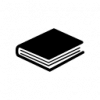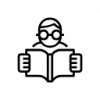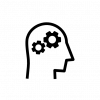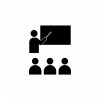DESN2000 Engineering Design and Professional Practice is a second-year engineering design course that is meticulously crafted to enhance the proficiency, competencies, characteristics, and aptitudes required to produce engineering solutions through the application of design thinking methodologies. While the majority of courses within the UNSW Chemical Engineering program predominantly focus on identifying technical resolutions to challenges, DESN2000 advocates for a paradigm shift. Students must contemplate their users' needs and viewpoints before venturing into the development of a technical solution. Consequently, this fosters the generation of more user-centric and fit-for-purpose solutions.
There are two challenges when designing this type of courses:
- First, the principle of design thinking proves complex when applied within a chemical engineering context. Projects in this field often encompass intricate technical aspect that are challenging to align with the user-centric paradigm of design thinking. The extended duration and considerable costs associated with chemical engineering projects further complicate the integration of prototyping and testing into the design procedure.
- Second, students often have difficulty conceptualising and contextualising user-centred problems and solutions in the field of chemical engineering due to the number of stakeholders that are involved. These stakeholders include government bodies, regulatory bodies, project proponent and end-users. Moreover, engineering students often have misconceptions about the relevance of the design thinking approach and perceive it to lack of technical rigour.
To address the challenges inherent in course design, I selected the design of green hydrogen transport infrastructure as a case study. Hydrogen-based transportation systems has been anticipated to offer significant benefits but face significant techno-economic and social challenges, including high production, storage and distribution costs, a lack of infrastructure and an existing value chain, competition from other renewable energy sources, and safety concerns. As such, I encouraged students to apply design thinking in conjunction with technical analysis to address the challenges of the hydrogen economy.
To ensure a comprehensive approach, students were required to research the stakeholders impacted by the design, including proponents and investors, government entities, end-users, communities, and the environment. Students were then tasked with defining the problem statement, setting design objectives, generating ideas, building prototypes, conducting user testing, and articulating the value propositions and feasibility of their designs in a design pitch. To facilitate this process, I designed a series of learning activities that enabled students to gain a deeper understanding of the design thinking process, as well as to develop the skills and confidence necessary to solve complex problems in their future personal and professional lives.
To further enrich the course with career development learning, I present LinkedIn profiles of consulting engineers at various career stages and invite guest speakers with expertise in design thinking or hydrogen technology to share additional insights with my students. Students are also directed to explore the GPA Engineering website, make connect with their engineers and access real reports written by GPA Engineering; thus they can gain insights into the roles and responsibilities of consulting engineers.
Design 1 • Designs curricula, learning activities and resources to enable a range of learners to achieve course learning outcomes
To create an authentic learning activities and assessment tasks in DESN2000, I had the students role-play as an engineering team in GPA Engineering, an Australian consulting firm that specialised in hydrogen technology. I created a Project Brief introducing students to the, a government plan to create economic growth and jobs while reducing greenhouse gas emissions and enhancing energy security through the development of a domestic hydrogen industry.
In the simulated engineering consulting assignment, student teams were tasked with designing a solution for a consortium of hydrogen gas producer, distributor and hydrogen transport manufacturer, namely Coregas, Jemena, and Hyundai, who were also real world clients of GPA Engineering. The Project Brief provided detailed information about the clients and their needs, including constraints and limitations, for the student teams to consider. To prepare students for the project, I introduced them to the Australian Renewable Energy Agency (ARENA), a government body that provides funding and support for demonstration projects to accelerate the deployment of renewable energy technologies and increase the supply of renewable energy in Australia.
To reinforce the students' learning, I designed a series of hands-on activities that enabled them to apply the knowledge and skills they had acquired to their projects. These activities included researching and profiling stakeholders, identifying, and defining the challenges and constraints faced by stakeholders, and conducting a technical landscape review. As a team, students then brainstormed design solutions that best addressed the clients' needs. They assessed the merit of their designs, using approaches such as the Value Proposition Canvas to select the design that best met the requirements of their stakeholders.
Design 3 • Designs and sequences assessment tasks aligned with course and program learning outcomes
I used four different but fitting assessments tasks to capture and evaluate comprehensively students' attainment of the course learning outcomes.
Design Journal
The first assessment task I designed and implemented was a Design Journal in Microsoft OneNote Class Notebook. In this task, students document their understanding of the user-centred design approach to problem-solving by including notes, sketches, outputs of their workshop and research activities, analysis, as well as any decisions and design solutions made throughout the design process in an e-portfolio. By allowing students to communicate their thought process, insights, as well as the evolutions and evaluations of their design solution, the Design Journal assesses two key learning outcomes: (1) The ability to develop design concepts using standard methods to collect, assess, and integrate end-user, stakeholder, and project requirements; and (2) The capacity to validate the suitability of designs using standard technical methods while considering end-user and stakeholder contexts.
Technology Landscape Review
The second assessment task I designed and implemented was a Technology Landscape Review. Students are required to evaluate both current and potential applications of the technology, delineate its strengths and limitations, analyse the competitive landscape, discern market trends, and consider regulatory aspects relevant to the technology within an Australian context. This entails a comprehensive examination of scholarly publications, patents, and other pertinent literature associated with hydrogen technology. To support students in this assessment task, I curated a range of resources, including action plans, podcasts, essays, parliamentary submissions to deepen their understanding of pertinent issues related to zero-emission strategies and technologies. This task affords students the opportunity to exhibit their information literacy and communication skills by translating intricate technical information into a lucid and compelling analysis.
EOI for a Grant Application
The third assessment task I designed and implemented was an Expression of Interest (EOI) for the ARENA Future Fuel Program, a funding scheme for renewable energy projects, using a mock-up of a real ARENA EOI submission form in Microsoft Form. To further ensure authenticity and contextual relevance, students were directed to objectives, guidelines, FAQs, templates, promotion videos, and news releases from ARENA's website. Students were mandated to deliberate upon the nature of engineering design that can be achieved with a budget of $5 million and to discern the expectations of their clients, governments, and taxpayers. Additionally, they are required to assess the technological and commercial readiness levels of their design, formulate a comprehensive risk management plan, and present their design to stakeholders through a formal presentation. My approach challenges students to write concisely, professionally, and persuasively, further enhancing their communication skills.
Career Development Learning
The fourth assessment task I designed and implemented involves using the STAR method as a tool for students to reflect on their professional attributes and career development learning. The STAR approach is widely used to provide structured and effective responses to questions in behavioral and competency-based interviews, potentially enhancing students' employability. This assessment increases students' understanding of potential career trajectories within the engineering consulting and design sectors and helps them navigate potential career paths within the sector. By providing practical insights and guidance, this approach equips students with the skills and knowledge needed to succeed in their future careers.




